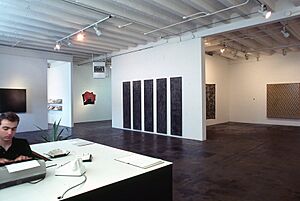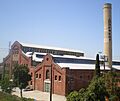Arts District, Los Angeles facts for kids
Quick facts for kids
Arts District
|
|
|---|---|
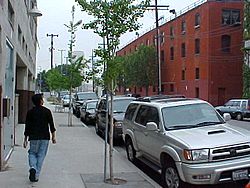
The Arts District
|
|
| Country | |
| State | |
| County | |
| City | |
| Area code(s) | 213 |
The Arts District is a cool neighborhood on the eastern edge of Downtown Los Angeles, California. It's known for its many art galleries and creative spaces. The area is bordered by Alameda Street to the west, First Street to the north, the Los Angeles River to the east, and Violet Street to the south.
This district used to be full of industrial buildings from the early 1900s. But recently, it has been given a new life! Its streets have become lively with art and culture. Many new art galleries have opened, making the Arts District a famous spot for art lovers in downtown Los Angeles.
Contents
History of the Arts District
How the Arts District Began
A Spanish priest named Juan Crespi explored this area in 1796. He found a place with rich soil and water. He wrote in his journal that if a town were needed, it should be called "Our Lady Queen of the Angels." This small town, or pueblo, was officially founded on September 4, 1781.
Vignes Street is named after Jean-Louis Vignes. He was an adventurer who came to Los Angeles in 1831. He planted grapes on about 104 acres of land. By 1849, his vineyard, El Aliso, was California's biggest wine producer. Today, the San Antonio Winery reminds us of the area's past.
From Farms to Factories
By the late 1800s, oranges and grapefruits grew here instead of grapes. Filmmaker DW Griffith even filmed parts of his movie In Old California here in 1909. A print shop opened, hiring artists to design labels for fruit boxes.

The Santa Fe Freight Depot and warehouses were built to ship these fruits. These buildings shaped the area's economy for many years. They also gave the district its unique architectural style. In 2001, the freight depot became home to an architecture school.
Over time, factories replaced the citrus groves. By World War II, the area was mostly industrial. Many factories closed or moved away in the 1950s. This left many empty warehouses.
Artists Move In
Artists looking for affordable places to live started moving into the Arts District in the late 1960s. Before 1979, the buildings were only for industrial use. But in 1979, California passed a law allowing artists to live and work in these spaces. In 1981, the city passed the Artist-In-Residence (AIR) bill.
This law allowed artists to live legally in these old industrial buildings. They just needed a business license. New rules were made to make these lofts comfortable for living. For example, lofts needed a place to sleep and a fire alarm.
The Arts Scene Blooms
Art in the 1960s and 1970s
In 1969, Allen Ruppersberg created Al's Cafe. In the mid-1970s, artists like Joel Bass and Jon Peterson saw a chance in the empty buildings. They turned old factories into studios and homes. They could rent space for very little money. This led to a burst of artistic activity.
LA Artcore was started in 1976 by Lydia Takeshita. It aimed to show local artists' work. Lydia Takeshita and LA Artcore are seen as key to the Arts District's beginnings.
In 1979, Marc Kreisel opened Al's Bar. This famous music spot hosted bands like Sonic Youth and Red Hot Chili Peppers. It was also a meeting place for artists and sometimes held art exhibitions. Al's Bar closed in 2001.
Art in the 1980s
The Atomic Cafe was a popular spot for artists and musicians. Los Angeles Contemporary Exhibitions (LACE) held shows in its gallery. Several art galleries opened in the late 1970s and early 1980s. Cirrus Editions, the first gallery to open downtown, is still open today.
In 1981, Los Angeles passed the "Artist in Residence" (AIR) law. This law made it legal for artists to live in buildings that were once only for industry. As more artists moved in, art galleries, cafes, and performance venues opened.
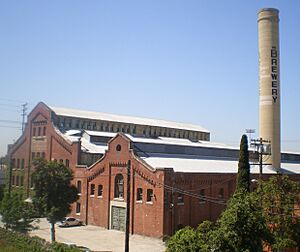
In 1982, the Brewery Art Colony opened in an old brewery building. In 1999, the Los Angeles Times called it the "world’s largest art complex."
Other creative spots opened in the 80s. Bedlam offered drawing workshops, art shows, and live music. Dangerous Curve showed unique art. The Spanish Kitchen hosted events and parties.
In 1985, an art show called "Off the Street" featured 48 Los Angeles artists. Most of them lived downtown.
Art in the 1990s and 2000s
In 1994, the Downtown Arts Development Association (DADA) was formed. This group helped the growing art scene. DADA showed works by over 400 downtown artists. Joel Bloom, who ran Bloom's General Store, was known as the Arts District's unofficial mayor.
Cornerstone Theater, a group that brings community theater to different places, was on Traction Avenue for 20 years. ArtShare, a nonprofit, offers art, dance, theater, and music lessons to young people.
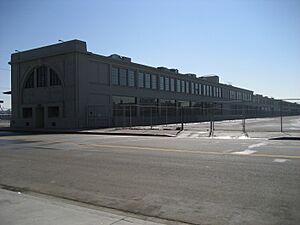
In 2001, the Southern California Institute of Architecture (SCI-Arc) moved to the former Santa Fe Freight Depot building. It has become a key part of the Arts District.
In 2020, the website la-artsdistrict.com was launched. It highlights the Arts District's mural art and artists. It also has a map and photos of the murals.
The A+D Museum of architecture and design, founded in 2001, is also in the Arts District.
Famous Landmarks
The Los Angeles Conservancy lists several important landmarks in the Arts District:
- Pickle Works/Citizen Warehouse: 1001 East 1st Street
- Challenge Dairy Building: 929 East 2nd Street
- Southern California Supply Co.: 810 East 3rd Street
- Southern California Institute of Architecture: 960 East 3rd Street
- American Hotel: 303 South Hewitt Street
- Toy Factory Lofts: 1855 Industrial Street
- Biscuit Company Lofts: 1850 Industrial Street
The Arts District Today
The Arts District continues to grow and change. The area faces challenges like the rising cost of living and the loss of historic buildings. Community leaders are working to keep the district's creative spirit alive. In 2014, the average yearly income for residents was $120,000.
The Southern California Institute of Architecture (SCI-Arc) is in the old Santa Fe Freight Depot. This building is on the National Register of Historic Places. Across the street is One Santa Fe, a large apartment complex that opened in 2014.
An old Coca-Cola factory from 1915 has been turned into new creative spaces. It's now called Fourth & Traction. The Hauser Wirth & Schimmel art complex opened in 2016. It takes up an entire city block.
The district is a popular place for filming movies and TV shows. The TV show New Girl is set in an apartment loft here. However, filming has become harder due to new shops and residents.
In 2017, a big project called "6 am" was proposed. It would include apartments, shops, offices, and hotels. New developments have made it harder for artists to afford to live here. In 2016, the average property price was $714,500.
In 2017, the district received $15 million to improve bike lanes, sidewalks, and street lighting. This will make it easier for people to walk and bike. The Sixth Street Viaduct, rebuilt in 2022, connects the Arts District to the Eastside.
Warner Music Group moved into an old Ford Motor Company assembly plant in 2019.
Getting Around the Arts District
The Arts District is easy to reach by public transport. The Metro L Line station was on Alameda Street. It was replaced by an underground station in 2023. This new station is on the A and E lines.
The LADOT DASH bus also serves the neighborhood. It has stops on Hewitt Street.
Metro also has a bike share program. You can pick up or leave a bike at these stations:
- 740 East 3rd Street
- 999 East 3rd Street
- 1245 Factory Place
- 1301 Willow Street
- 720 East Temple Street
There are also sixteen parking lots in the Arts District. As the area became more popular, parking became a challenge.
There are plans to extend the Metro Rail's B Line and D Line subway lines to the Arts District. This would make public transit even better for the growing community.
Art and Design Schools
The Southern California Institute of Architecture (SCI-Arc) moved to the historic Santa Fe Freight Depot. This school is a major part of the Arts District.
Otis College of Art and Design used to be in downtown Los Angeles. In 1997, its main campus moved to Westchester.
The Fashion Institute of Design and Merchandising (FIDM) is also in downtown Los Angeles. As of 2023, FIDM is part of Arizona State University (ASU) and is now ASU FIDM. The nearby Los Angeles Fashion District has historically offered jobs for artists working with textile designs.
Images for kids



